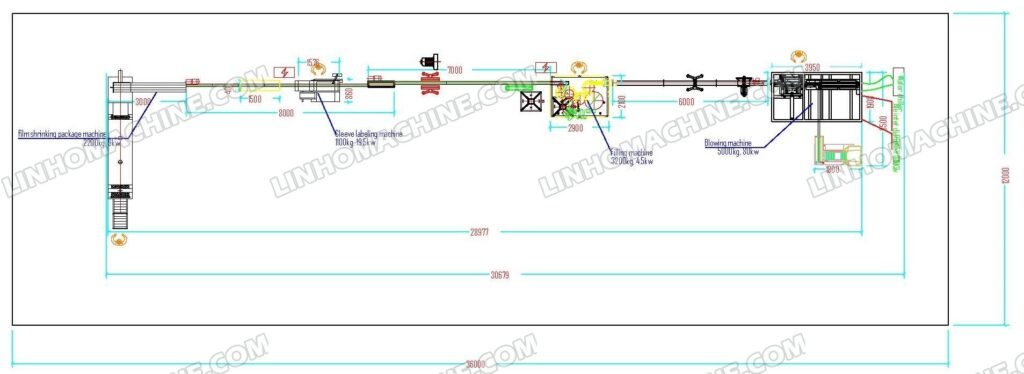The size of the filling plant workshop is determined by the scale of the filling production line.
Under the premise of meeting the daily production, the larger the area of the workshop, the better. The following figures are production workshop layout diagrams based on the production line of three scales. Small, medium, and large. These diagrams are for your reference.



In our actual communication, we will draw the plant layout according to the size of your production line, the type of beverage, and the size of the workshop. In the layout of the entire plant, the following principles are mainly followed:
1. Water treatment is close to the water source. Take well water sources, for example. Well water enters the reservoir through deep well pumps and pipes. Yes, you will need a cistern or tank to temporarily store well water. The raw water is then supplied to the water treatment system from the reservoir or water tank. The purpose of this is to protect water treatment from excessive water pressure generated by the deep well pump, while playing the role of continuous water supply to the water treatment. The water treatment is close to the water source, which can greatly save the pipeline and ensure the cleanliness of the water source.
2. The packaging machine exit is close to the finished product workshop. Packaged beverages should be transported to the finished product workshop in time for storage. It is to avoid congestion in the processing plant. The packaging machine outlet is close to the finished product workshop, which can greatly reduce the time and cost of the transfer. Therefore, the export of packaging machines should also leave sufficient space for workers and forklifts to work.
3. The blow molding machine is close to the filling machine entrance. If the blow molding machine is not directly connected to the filling machine, ensure that the blow molding machine is close to the filling machine entrance. In this way, the blown bottles can be supplied to the filling machine in time. It saves time and ensures that the bottles are clean.
4. Multi-story workshops need to prepare space for the lifting conveyor systems. If your workshop has several floors, you need to fully consider the convenience of transporting products between floors. The common production uses a spiral lifting conveyor (pictured). This conveyor system enables smooth transport of products between different floors. In this case, the finished product workshop is best placed on the first floor. It’s easy for truck loading.

5. Machines with loud noise are separated from the staff work area. Noisy machines such as air compressors are best placed in a separate space. So as not to affect the working environment of workers.
Depending on the national standards of each country, it may be necessary to prepare a clean workshop. In the food and beverage industry, the filling workshop generally adopts a 100,000-level purification workshop.
In addition to the arrangement of the production line workshop, you also need to prepare the raw material storage workshop. The requirements for the raw material workshop are as follows:
1. Labels, packaging films: Shrink labels and shrink films are stored at 0 to 25 degrees Celsius. Avoid direct sunlight. The storage conditions of self-adhesive labels are about 23 degrees Celsius and the relative ambient humidity is 55%. Avoid direct sunlight and rainforest.
2. PET preforms and PP caps: should be stored in ventilated, cool, dry, free of chemicals and toxic substances contaminated warehouses. The storage temperature is below 30 degrees Celsius and the relative humidity is maintained below 70%. The storage period shall not exceed one year from the date of manufacture.
3. Carton: rain and snow, exposure, moisture, and pollution should be avoided. And should be stored in a ventilated and dry warehouse, and the ground floor height is not less than 100mm from the ground. The storage period is generally not more than half a year.
4. Formulation ingredients: The storage conditions of different ingredients are different. You should store according to the recommendations of the ingredients manufacturer. The following are ways to store several of the more common ingredients.
Fruit pulp and concentrated juice:
Aseptic filling products are stored at room temperature. Avoid exposure or high-temperature storage. And stored in the warehouse when the outdoor temperature is higher than 10 °C. Low-temperature preservation products should be stored in cold storage at a temperature ≤-18 °C.
Tea:
Tea loves to absorb odors, and is more afraid of moisture, high temperature, and light. The optimal temperature for tea storage is 0 ~ 10 ° C. The storage period of the temperature around 15 °C cannot exceed 4 months. And the storage period should not exceed 2 months when the temperature is above 25°C. Otherwise, there will be more obvious discoloration and taste changes.
Fructose:
Fructose is a hygroscopic food, afraid of moisture, heat, and cold. Therefore, it is necessary to store it in an indoor relative humidity of no more than 70%. The surrounding sugar storage environment can not be less than 0 ° C. Below 0 ° C, fructose will be frozen and clumped. The sugar storage environment in summer should not be higher than 35 ° C. The sugar will melt if the temperature is too high.
White sugar:
The relative humidity of the air in the storage warehouse is ≤70%, and the temperature is ≤ 38 °C. Stacked separately according to the variety. Do not store it in the same warehouse as other items that can affect the quality of white sugar. Sugar packets should be placed on wooden stock 1 meter away from the wall, heating pipe, or cement column. And the wooden stock should be more than 10 cm above the ground. The stacking height should not exceed 10 packs. Cover the pile with plastic film or clean canvas. Dust and dirt on the outer packaging are strictly prohibited.
Flavors and fragrances:
Stored in a cool, dry, and clean warehouse, and must not be stored in the same warehouse as toxic, odorous, and volatile items. Storage temperature of 10-30 ° C is appropriate,
Enzyme:
The storage temperature of enzyme preparations is ≤ 25 °C, and other excipients are stored at room temperature.
The workshop used to store the filled and packaged products is called the finished product workshop. Depending on the product, the requirements of the finished product workshop are also different. Products that need to be transported in the cold chain, such as yogurt, juice, etc., are stored at a temperature of 3 to 5 degrees Celsius. General hot filling juice, soda, and beer can be kept below 30 degrees Celsius. The gate of the finished product workshop should leave enough space for the loading and transportation of trucks.
If you have additional questions, please contact us.


